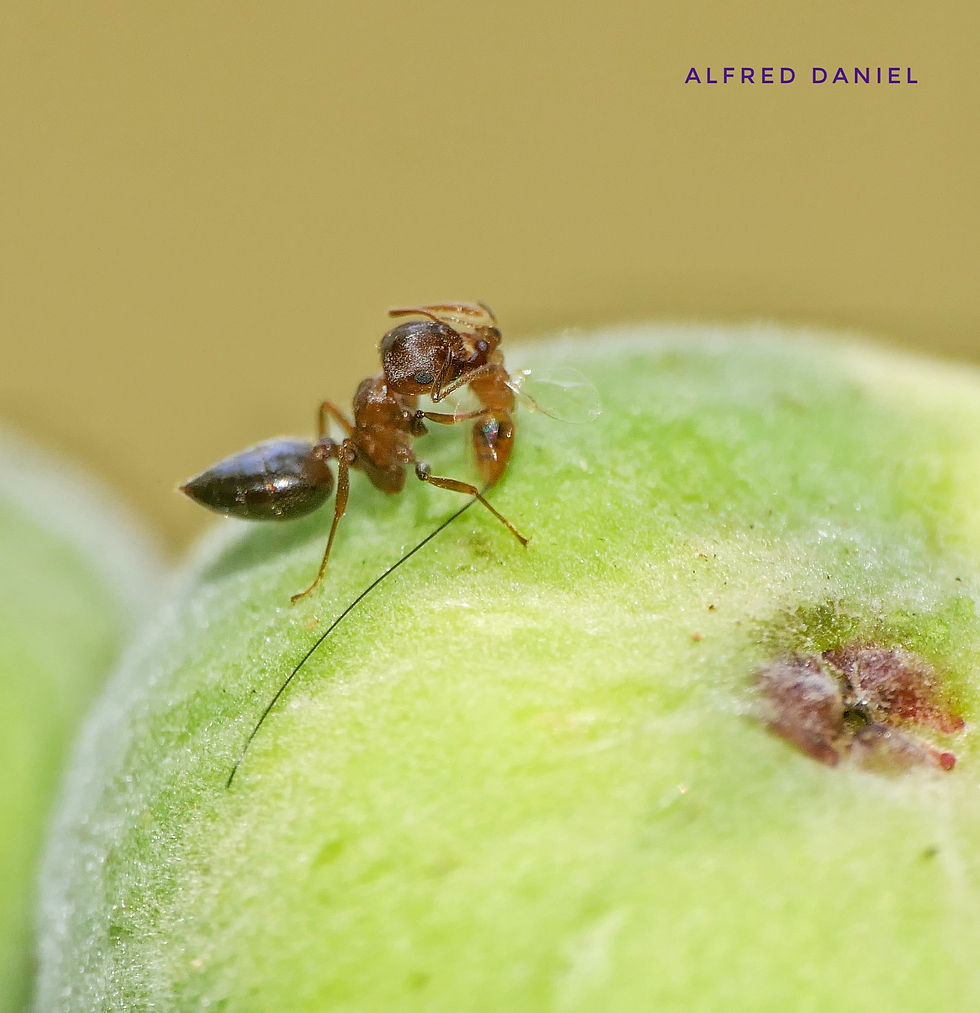"Power is not of the mighty" fascinating story of fig wasps.
- danieljalfred
- Feb 5, 2023
- 4 min read
Updated: Jun 30, 2023
Power is not of the mighty
No, no it is not!
Centuries lie on that which lives a mere few hours
A drop of water as powerful as roaring floods
The minute balance of life
Lies on the reigning queen
A wonder so small, can fly through an eye of a needle
A wonder seemingly insignificant, yet holds within, power
Power over thousands of lives, ecosystem across continents!
There are over 750 types of figs worldwide, each one essentially requiring pollination by its own unique species of wasp called Fig wasps. If not for these tiny, teeny wasps, there won’t be any fig trees and fruits. One may ask, ‘so what?’ A question I hope not to be of ignorance but of curiosity. Yes, these fig wasps are so small, out of sight, and so seemingly insignificant. However, the power they hold over the lives of many holds no bounds. One tiny fig wasp that lives mere few hours carries the power of centuries, to sustain a wide ecosystem that depend on figs for their lives (from food to hunting ground to shelter).
In simple terms:
Fig flowers offer a nursery where these fig wasps can lay eggs and raise their young. In turn, fig wasps distribute fig pollen, enabling the plant to make seeds and reproduce.
A perfect rhythmic mutualism.
However, of course, life is never simple. It is a complex tangle of mystery and wonder: Firstly, a fig is not a fruit but a bouquet of hanging flowers. Once it reaches of age, an immature fig emits an odor to signal that it is ready to be pollinated. Attracted by that odor, the female fig wasp lands on the green runway and searches for the secret door. There is none but a crack to squeeze through. Why get discouraged? If there is no obvious door, you make one! She burrows deep into the fig, tunneling a passageway for herself so narrow that she loses her wings. She will not need them anymore. The door shut behind her, a protection and a fate sealed, she will die in the dark interior of the fig after laying eggs.
Once inside, she explores the secret garden, moving from flower to flower, laying her eggs and sharing her history (spreading the pollen she has brought with her from the fig where she was born). The flowers she pollinates will soon produce seeds; the eggs she lays will hatch and her larvae will feast on this fig flower tissue.
Now here is where the story takes a scandalous turn: the male fig wasps hatch first, tiny and wingless, to mate with their unborn sisters inside the fig. Therefore, the newborn females are already pregnant when they hatch. After this pedophilic incest, the male fig wasps tunnel their way out, paving the path for the females to come out. Born and bred inside a fig, female fig wasps emerge out carrying a load of pollen, ready to lay their eggs in another immature fig and begin the life cycle of a new generation.
Wait, are you telling me that when I eat a fig fruit, I am also eating dead insects?
No, the delicate crunch you hear when you eat a fig fruit is not the remains of a wasp; it is indeed the sound of seeds. Fig trees produce an enzyme called ficin that digests protein. Ficin dissolves the wasp’s body, reusing the nutrients to nourish the fig.
The cycle of pollinator and pollination comes to an end with the hidden cave forever shut; the plant is the carnivore in this case.
OH wait, wait – this is not the end!
So far, I have talked about pollinating fig wasps. Apart from this, there are many non-pollinating culprit fig wasps that lay their eggs inside the fig and degrade the quality of the fig. From battles with parasitoids that aim to save the figs by parasitizing these culprits and patrolling predatory ants that wait in line to kill these culprits while they lay their eggs, the side stories of these non-pollinating fig wasps are not any less exciting. Curious? Scroll down to see more.
Documented and photographed by Alfred Daniel J while he was working in IISc, Banglore under Prof Renee Maria Borges (the ultimate fig wasp researcher). Alfred developed interest to write this as a blog because of his current advisor Prof. Michal Segoli (the ever encouraging & incomparable advisor) who expressed her wish of watching "Queen of trees" together as a lab.

Ceratosolen fusciceps - a pollinating fig wasp on the flower of Ficus racemosa. You can also see a clipped off wing (on the small aperture of this flower bulb tip) of an wasp that already entered in to pollinate.

Sycophaga fusca - the non pollinating and galling wasps that degrade the quality of figs and compete with the food resources of the pollinating wasps within the fig. In other words, they suck nourishment from fig without offering any benefits.

Apocrypta westwoodi - the wasp that parasitize the non pollinating galling culprit wasp just landed to do its duty to save the fig

Do you know?? its ovipositor is reinforced with zinc so as to penetrate well.

Once inside the fig, their ovipositors manoeuver around flowers seeking the right spot for their eggs to be laid - so that their emerging offsprings can kill the non pollinating culprit wasps. They can sniffs with Its bum !!!!

Crematogaster The patrolling ant that protect figs from these non pollinating wasps by killing them and thereby saving figs and fig wasps

Crematogaster killing an non pollinating wasp. Fig trees aren’t helpless!!


Comments